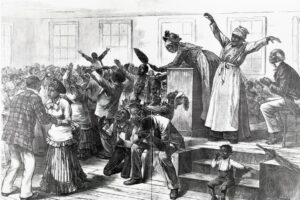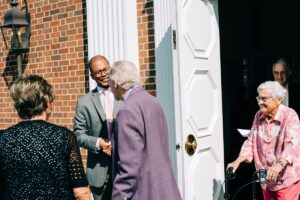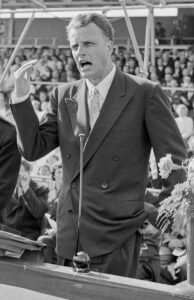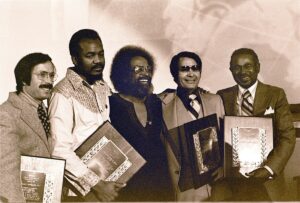
Illust.Of Black Church Ceremony;New Year [Getty Images] (Original Caption) Virginia- ‘De Lord will take care ob de colored folk.’ -Seeing the old year out and the new year in- Scene in the colored church at Grafton, near Yorktown, during the watch meeting
In 1958, a pastor preached these words to their congregation, “A human being is essentially a creature who necessarily and forever believes in something. The only cure in this world for the wrong use of faith, is the right use of it. Deep at the center of every personality, where we handle our own solitariness, we are working out success or failure, salvation or destruction, by our use of this perilous power …”[1] It is a powerful statement regarding the use of faith in humanity. However, does this statement still pull on your faithful heart strings or hold power, when you realize these words were shared by the infamous cult leader Jim Jones? Yes, the sermon was given 20 years before the massacre in Guyana, but does everything you know, including your assumptions about Jim Jones, still allow the excerpt to seem powerful?
Research Question and Significance
While the example above may seem extreme, the fact is, before words even leave the preacher’s mouth, the audience comes in the building with expectations and perceptions. Experience has led me to gather that my presence as a theologically and politically progressive Black man in my predominantly white congregational context creates unconscious assumptions before I even utter a word.
The present research project seeks to ascertain answers to the question, “Do the hearers’/audiences’ perceptions and assumptions of the preacher affect reception of the proclaimed word?” We all have perceptions of individuals in our lives, whether we place them on a pedestal or regard them as scum of the earth. This is no different when the individual carries the title “Reverend.” This research considers how certain expressions affect the relationship between preacher and congregation and their reception of the sermon.
By answering this question and those that accompany it, congregational leaders might help sermon listeners better understand how their own conscious and unconscious biases influence their characterizations of the preacher and what they receive from the sermon. Our perception of spoken content contributes to how we judge the preacher and how we respond or react. The hope is to build better relationships between clergy and congregation.
Ministry Context
Right on the corner of Westchester and Country Club Drive is where you will find Emerywood Baptist Church. Theologically, the church has always been a progressive Baptist church. Emerywood was incorporated in 1962, began ordaining women in the 1970s, left the Southern Baptist Convention in the early 1980s, has always been open about drinking and dancing, and has even welcomed a minister ordained in the Unitarian Universalist tradition as a beloved pastor. Additionally, in 2017, they voted to call a single, 27-year-old progressive Black man as their next senior minister. Even with this history, many members age 60 and above never have viewed their church as “progressive.”
 Emerywood’s identity has tended to be quite vague. Ask the average congregant what the identity of the church is, and they’ll usually answer in line with their presumption of the senior minister’s views at that time. Therefore, anytime a new senior minister arrives, the church experiences a great shift in culture, support, and even audience.
Emerywood’s identity has tended to be quite vague. Ask the average congregant what the identity of the church is, and they’ll usually answer in line with their presumption of the senior minister’s views at that time. Therefore, anytime a new senior minister arrives, the church experiences a great shift in culture, support, and even audience.
In my experience, how the congregation perceived preaching was influenced not only by race and gender and politics but by the “culture wars” raging outside the church. The biases congregants brought to Sunday morning worship shaped how they heard the sermons — as did their perceived history of the church itself.
Research Project
I began my Doctor of Ministry degree during the Covid-19 pandemic. Therefore, this research was not widely known to congregants. An email was sent out to 50 congregants requesting their participation in the study. These individuals were hand-picked to create a diverse grouping of people on gender, age, sexuality, political partisanship, socioeconomic income, and range of time in being associated with Emerywood Baptist Church. Because Emerywood is a predominantly white congregation, it was not possible to create a sufficient diversity of races.
Those asked to participate were told the process would last six to seven months and were asked to commit to each step of the process. They also were informed one of the phases in the research would be anonymous. Of 50 people approached, 30 committed to the study. The study happened in 3 phases:
- Survey-The intent of my research was to assess what might cause a congregant to cast a negative or positive judgment upon the preacher. Doing so required understanding congregants’ views and biases, or what they believe to be believable.To understand this, I created a survey of a wide array of questions. This aspect of the research was anonymous.
- Written Sermons-Each participant received a packet of four written sermons to evaluate. These sermons were chosen in response to the survey answers. It was important to incorporate theological views that all in the study would find agreeable and disagreeable. My hope was to gather sermons from well-known preachers who have some celebrity status and who would be known by the survey participants-Billy Graham, Paula White, William Barber II, and Nadia Bolz-Weber.
 For each of these sermons, the preacher’s identity was hidden. Every word and “umm” was written down to capture the fullness and integrity of the preacher. While reading a sermon is much different than listening or watching, it is the only way the participant can get the full gist of the message/theme.
For each of these sermons, the preacher’s identity was hidden. Every word and “umm” was written down to capture the fullness and integrity of the preacher. While reading a sermon is much different than listening or watching, it is the only way the participant can get the full gist of the message/theme. - Watched Sermons-After waiting close to three months, we began the next phase. The participants were only told there would be another round of sermons and nothing pertaining to whether the sermons were the same as the last grouping or different. Because they were, in fact, the same sermons, it was critical to allow time for individuals to forget the written sermons and to be able to have a different evaluation. This last phase of the study focused on participant observation. Split into separate groups, fifteen one day and fifteen another, individual participants heard biographies of each preacher and watched the same sermons they had read earlier. All biographies were taken online so that I would not share bias of either preacher.
Conclusion
Yes, the congregation’s perception and assumptions of the preacher affect reception of the proclaimed word, but a practical result of the research for me was adapting my own preaching style. Through mapping the congregation—understanding these 30 congregants in the study as representative, understanding their biases, becoming empathetic to the experiences that shaped them, and observing how their unconscious shaped how they received a sermon—I in return became a better preacher and pastor. I was able to draft sermons with them in mind. I was able to engage in conversation with some to better understand “why” they believed what they believed. Due to this research, how I preached “hot-button issues” changed to ensure my congregants could hear and receive it better.
80% or more of those who participated would come discuss with me when they were triggered by something in a sermon rather than walking away and adding more perceptions to their characterization of me. I became a trusted member in their physical world and allowed to help shape and experience their theological world.
- What does this mean for every Sunday preachers and their congregants? Congregational consciousness is, in fact, necessary. If we are not conscious of our congregations, how will we ever know their perceptions, critiques or even desires.
- If we as ministers are not invited as trusted confidants into the theological world of our congregants, the trend will continue of congregants leaving anytime they hear something that goes against their experience and views.
- The question still stands, “What do we do with a listener’s perceived ethos of the preacher?” The source of ethos is credibility, and by building credibility, the preacher gains trust. How one builds this credibility is determined by the context they are in.
Further Resources
Allen, Ronald J. Hearing the Sermon: Relationship, Content, Feeling. St. Louis, MO: Chalice Press, 2009.
Belinsky, Scott. “On the Self , Others, and Experience: Understanding Our Relations with Others as Perceptual Powers,” 2019.
Curtis, Mark E. “Ethnography, Conflict, and Pastoral Leadership,” 2021.
Fayad, Sarah. “Solidarity as Belonging-to and Dying -for Martyrdom, Hope, and Ethical Harmonies of the Flesh,” 2021.
Hopewell, James F., and Barbara G. Wheeler. Congregation: Stories and Structures. London: SCM, 1988.
McClure, John S. Listening to Listeners: Homiletical Case Studies. St. Louis, MO: Chalice Press, 2004.
Mulligan, Mary Alice, Diane Turner-Sharazz, Dawn Ottoni Wilhelm, and Ronald J. Allen. Believing in Preaching: What Listeners Hear in Sermons. St. Louis, MO: Lucas Park Books, 2014.
Smith, James K.A. How (Not) To Be Secular: Reading Charles Taylor. Grand Rapids,, MI: William B. Eerdmans Publishing Company, 2015.
Tisdale, Leonora Tubbs. Preaching as Local Theology and Folk Art. Minneapolis, MN.: Fortress Press, 2010.
Work Cited

